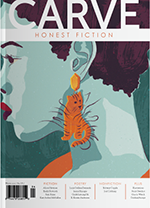Joel Coltharp teaches creative writing at Missouri State University and is Fiction Editor for Moon City Review. His fiction, nonfiction, poetry, and interviews have appeared in Lake Effect, Notre Dame Review, SmokeLong Quarterly, and other journals.
Joel’s essay “What We Do With Them” appears in the Winter 2020 issue of Carve. Order your copy here.
Your essay relives a period of your life when you were working in a funeral home, a job that your father also held. I think the job itself is one that readers would immediately be interested in reading about, but often times what seems normal to us is hard to step away from and write about. Was this experience something you always knew your would write about, or did it take time to reflect back on this period of your life?
I would say I always knew I would write about it eventually, and people who were aware I had worked at a funeral home had long pressured me to do so, but it took all of the ensuing years to develop a complete understanding of why these particular events held such significance for me. My initial attempt to get them down on paper resulted in a somewhat rambling narrative of assorted funeral-home facts and moments—more recitation than reflection. I think it took years of just telling my stories to other people to first notice that the core narrative depicted in my essay had emerged as one of the most startling memories and to then recognize that the interplay between it and the more horrific details from my time working at the funeral home—reflecting how the world of the living could become just as alienating as that of the dead, while, at the same time, calling into question the perspective of those who spend most of their waking moments around the latter—was the true story I wanted to tell.
One thing we really like about this story is that it is single-scene driven, but it offers a feeling of a longer timeline with small asides or information about the embalming process at the funeral home. How did you decide to tackle this piece? Did you try writing it as a thematic essay at any point, or was it always based around this one, larger scene?
Even in its earliest form, it was always based around this one, larger scene, but I can’t take full credit for that. The focus formed organically, inspired by the aforementioned telling of my funeral-home stories to other people. If I referenced, say, the bodies moving, or if I described the embalming process to them, I would usually get a brief, strong reaction, the exact type of thing I expected, but it was this story of the father taking photos of his just-deceased son that always, without fail, elicited follow-up questions: Why would he want to remember the son in that condition? Why didn’t he show any emotion the entire time? What was he going to do with those images?
It was the realization that I had only asked myself those same questions quietly, in the back of my head, as though I had normalized the father’s behavior, to some degree, amidst this backdrop of death’s putrid imagery, that fully revealed how disorienting working at such a place can be. At the same time, recognizing that I had always given that story the same attention as I had the more graphic memories established it as the one I most wanted to tell. Strangely enough, I found not having the answers to those questions actually benefited the central narrative in the final version of the essay. And, of course, while making this one, larger scene the main focus, I still took a thematic approach to constructing the asides, trying to have the best of both worlds, I suppose.
At what point did your career path transition to writing? And what writers would you recommend to our readers?
I eventually left the funeral home after getting my fill of disassembled bodies and the overnight hours. I worked in the newspaper industry—in a non-writing capacity—for a while, but seeing that it was contracting rapidly, I decided to go back to school to find a more enduring career path, and I was open to pretty much any possibility. I took a few English classes and found that I had a real love and aptitude for both the act and study of creative writing, so I headed in that direction, stuck around for a couple of degrees, and made it my career in terms of both teaching and writing.
When it comes to my nonfiction work, I find myself fighting an ongoing battle between focus and context—trying to resist pursuing the latter at the expense of the former—so I pull inspiration from two books that offer the kind of balance I look for: Nick Flynn’s Another Bullshit Night in Suck City and Beth Ann Fennelly’s Heating & Cooling. In terms of narrative structure, I tend to split the difference between them, but for those seeking to learn how to approach their subject matter from odd angles, those two books are hard to beat. I also try to track down everything from Jaquira Diaz and John McNally because of how well they explore the relationships between specific people and the places that produce them.

